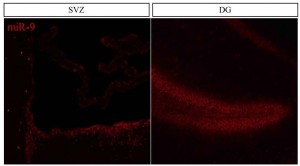Of mice and zebrafish
Posted by skatzster, on 16 June 2014
This story starts with me shaking and nervous and stumbling through my mid-term thesis committee meeting presentation. Not only was I presenting the results from the first half of my PhD but on top of that, I was presenting this work to Francois Guillemot, basically a legend in the field of developmental neurobiology. Luckily for me, my nervousness was completely unfounded and I quickly learned that Francois is not only incredibly knowledge but also very friendly and not at all intimidating. I presented the data I obtained that demonstrates an essential role for microRNA-9 (miR-9) in regulating the quiescent state of neural stem cells (NSCs) in the adult zebrafish pallium. After providing me with a lot of helpful insight and advice he generously offered to have me come to his lab to look at miR-9 in the NSCs of the adult mouse brain. Additionally, his lab had recently optimized a protocol to induce quiescence in vitro in primary adult hippocampal derived NSCs (AH NSCs) which would be a great model in which to test the expression of miR-9 in quiescent versus activated NSCs.
I immediately accepted his offer without hesitation but I soon realized that traveling to and staying in London might end up being quite expensive. Luckily for me, the money provided by the Development Travelling Fellowship enabled me to spend 3 weeks in the Guillemot lab at the NIMR in Mill Hill.
The time I spent at the NIMR in Mill Hill proved to be extremely fruitful and scientifically enriching. Upon my arrival in the Guillemot lab I was greeted by an incredibly friendly group of people and I knew that I would have a great time in the lab. Additionally, all of the mouse samples and cells were ready for me so no time was wasted and I was immediately able to start my search for miR-9 in the mouse brain. Everyone in the lab was incredibly organized and helpful which enabled me to complete a tremendous amount of work and in the end I obtained exciting results showing that miR-9 is highly expressed in the dentate gyrus (DG) and subventricular zone (SVZ), the two germinal zones of the adult mouse brain (see figure below), and also that miR-9 is much more abundant in quiescent NSCs compared with proliferating NSCs in vitro. Additionally, the NIMR is an incredibly stimulating scientific environment and I had the good fortune to attend a number of very interesting lab and departmental meetings and seminars. All of this on top of scientific discussions at the pub!
Overall, thanks to the generous Development Travelling Fellowship, I had an incredibly productive and scientifically stimulating 3 weeks in Mill Hill. I was able to obtain results that will be of great benefit to my PhD project, I learned a number of useful techniques and most importantly, I met a bunch of interesting young scientists that I am looking forward to seeing again soon!



 (3 votes)
(3 votes)